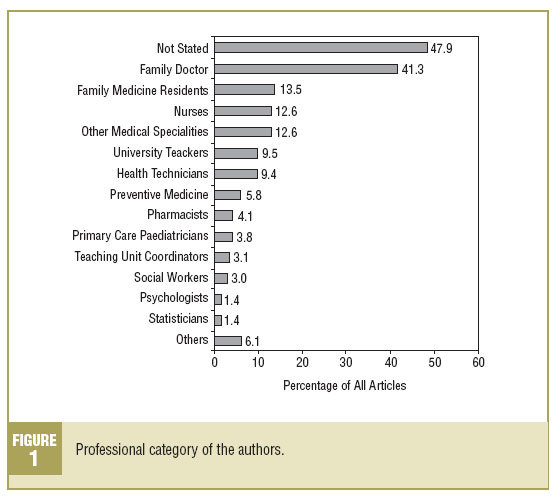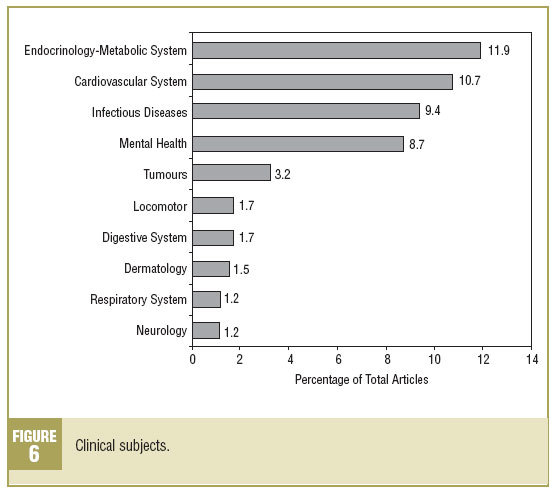a años anteriores no ha variado demasiado, algunos hallazgos positivos, como la emergencia de grupos de investigadores, la presencia cada vez mayor de estudios multicéntricos y multidisciplinarios, el mayor acceso a fuentes de financiación, etc., sugieren que estamos en un proceso de mejora de la calidad investigadora en atención primaria.
Introduction
Research is essential in every health care field and for all health professionals, since clinical practice, research, and teaching form a group which defines work quality.1,2 However, up to the beginning of the 1980's, research in primary care (PC) was anecdotal: between 1974 and 1983, less than 1% of medical articles published was related to PC.3 From then on it increased, reaching 4.1% of articles appearing in the IME (Spanish Medical Index) in 1994,4 owing to the reform of PC and the creation of the speciality of Family and Community Medicine (FCM).5 After this period of growth another of stagnation followed, which is were we are today.6 The number of projects, as well as financing of studies originating from PC by the FIS (Health Research Fund), have followed a similar pattern, and has been at a standstill since the beginning of the 1990s at around 4%.6-8 In general, although it has increased considerably in the last 20 years, research in PC is still considered to be limited.9
As regards the quality of the research in PC, it has been said that it is questionable and improvable, with poor discussions, design faults, most of the studies descriptive, with invalid surveys, carried out on general populations, with small samples, with few multicentre studies, etc.10-12 Multicentre studies and the lines of investigation which they follow are few,9 since the majority of the publications are sporadic contributions and only 4% of authors publish regularly (more than 5 publications in 10 years).13 Also, the scientific output from PC has a very low impact factor; the quotable articles coming from PC constitute only 0.4% of the total.13
In short, although there is more research than before, the quality remains the same.
In this context, we propose to analyse the articles published in the journal Atención Primaria during the last 10 years, by way of introducing the current state of research in PC and to find out, who, what and how it is being done.
Materials and Methods
This is a literature study in which original articles published in the journal Atención Primaria, form the first issue in 1994 until the last issue of 2003, are reviewed.
The following variables were collected:
Professional category of all the authors, distinguishing between family doctor, paediatrician, specialist in preventive medicine, other medical specialities, health technician, teaching unit coordinator, nurse, family medicine resident, pharmacist, psychologists, university professors, statisticians, and others. The category was recorded as shown in the article; in the case where there was more than one author, all were noted, while if none was given it was noted as "not stated."
If it was a multidisciplinary study: relationships of the various professional categories between the authors.
Type of work centre which appeared in the article, distinguishing between health centre, health administration (management, department of health, or similar), hospital, family medicine teaching unit, school of public health, research unit, support unit (family guidance centre, mental health unit or similar), research group (although it is not really a place of work, it was agreed to include it in this section), and others. In the case where there is more than one centre, all were noted.
If it was multicentred: participation of several centres in the study, if they were different institutions (university, management, health centres, etc) or several centres of the same type.
Autonomous community of origin. Where the authors came from several communities, all were recorded. To calculate the scientific productivity by community, the publication rate per 100 doctors was calculated for which the data from the Annual Report of Health and Medicine in Spain 2004,14 with regards to staffing levels in 2002, were used.
Study topic: classification based on that of the Canadian College of Family Doctors.15 The following categories are distinguished: provision of services, epidemiology, clinical, psychosocial aspects, methodology aspects, prevention activities, training and research. The cataloguing of the topics was carried out by a single investigator after reading the summary, or the full article if it was necessary.
Type of study: observational descriptive, observational analytical, or experimental. Qualitative studies and economic evaluations were considered descriptive, while meta-analyses were classified as experimental.
Evidence of any grant or financial assistance for carrying out the work.
Results
A total of 1229 articles have been reviewed. In 47.9% of the originals the professional category of the authors is not stated. As can be seen in Figure 1, after family doctors, the most frequent categories are residents of CFM and nurses. 31.4% of the articles are multidisciplinary.
As regards the work centres of origin of the authors (Figure 2), the majority are from health centres (62.0%). They are followed by health administration (23.0%), hospital centres (20.1%), family medicine teaching units (18.7%), and universities (16.2%). 20.5% could be considered multicentred.
By autonomous communities (Figure 3), Valencia, Madrid, Andalusia, and Catalonia took up 60% of the volume of publications. If we take into account the number of medical staff in PC to evaluate the scientific productivity of each community (Figure 4), we find that Murcia occupies first place (12.4 articles for every 100 doctors in PC), followed by Catalonia (9.7), Asturias (8.9), and Castile-La Mancha (6.1). As regards the research topic (Figure 5), the most common block is related to the provision and organisation of health services (40.5%), which includes studies on the use of the services, health costs, home care, inter-professional consultations, emergencies, etc. Epidemiology studies follow (22.5%), then clinical studies (19.3% with a rising trend in the last 4 years), and those related to psychosocial and behavioural aspects of the population (19.2%).
From a clinical point of view, the disease groups which appear most frequently in the articles published are: metabolic endocrinology (11.9%), cardiovascular (10.7%), infections (9.4%), and mental health (8.7%) (Figure 6), with diabetes (6.3%) and arterial hypertension (7.1%) being the most common diseases studied (Figure 7).
The large majority of the articles reviewed are based on descriptive, observational designs (94.2%), while analytical (1.4%) and experimental (4.3%) observational ones are scarce. Certain types of studies, such as qualitative ones, cost evaluations or systematic reviews (meta-analysis), are still rare (2.1%, 1.6%, and 0.3%, respectively), although a rising trend is seen in recent years. 16.2% of the articles involve some type of grant or financial assistance.
Discussion
The Atención Primaria journal was chosen due to it being the main reference for research publication in PC in our country and carries more than half the published studies.4,16 Obviously, other journals have not been reviewed, therefore our results should be evaluated with caution, since the presence of bias cannot be excluded. Also, we have to consider that not all studies end up being published.
It must also be taken into account that the categories of the different variables have been collected just as they appear in the articles, which may give rise to an under evaluation, for example, those published by family doctors (probably many of them are health experts or teaching unit coordinators, but they do not appear as such) or the masking of the studies carried out in health centres as being performed in management or teaching units. As regards authors, it is not surprising that the majority are family doctors, followed by residents and nurses. These results are similar to those in another study carried out in Catalonia between 1989 and 1991.17 What appears interesting, as it involves the scientific and professional enrichment of these studies, is that almost a third were multidisciplinary. Unfortunately, we have not found any reference to compare this figure and evaluate its progression over time.
In agreement with the study carried out by Fernández de Sanmamed, et all5 on doctors from Catalonia, the normal profile of the PC researcher is a family doctor after an internal medicine residency, 25-35 years old, who works in an urban teaching centre and has methodology and support resources.
As regards the centre of origin, the presence of FCM teaching units stands out, very much associated with research by several authors,17,18 Administration centres (with higher figures than the previous studies3,18) and the increasing appearance of "research groups." On the other hand, the limited (in our opinion) appearance of studies originating from research units has to be pointed out, which if confirmed in subsequent studies, ought to make us rethink their strategy and location.19
We have found a large number of multicentre studies in our study, much higher than that observed by other authors,3,13,17 by 6%-9%. Perhaps the difference is due to the use of different criteria at the time they were considered, although we believe that this form of investigation may have been influenced by the growth in research groups.
As regards the geographic origin, there have been few changes compared to the 1984-1993 period,13 except that Andalusia has unseated Madrid from second place and the Community of Valencia now occupies the position that Aragon occupied.
The topic diversity observed is enormous and indicates that the field of PC research is very wide, as much as it is in family medicine. The volume of articles on "health provision and organisation" (almost 40%), is about the same as that observed by other investigators.2,18,20 The fourth group is made up of "clinical studies," with an upward trend in recent years, perhaps due to a change in the editorial strategy of the Journal. More attention is given to "methodology" and "training" than the rest of the Spanish journals (1.8%),4 which has lead the search for a suitable model in PC and the its relative maturity.2 The low percentage of studies on "prevention activities" (slightly less than other studies18) should be pointed out in a field where prevention should have a stronger role.
In general, the topic analysis has not only confirms the large variety of research in PC, it also coincides with the interests established by the experts21-23: doctor-patient relationships, behaviour which leads to requesting care, performance, satisfaction, accessibility, continuity, effectiveness of prevention activities, efficiency, etc. In general, research in the health services and aspects which are related to clinical practice.
The lack of experimental studies is common in PC3,17,18,20,24 and reflects the difficulty of carrying out clinical trials in a field in which, apart from drugs, works with programs, advice, or prevention activities; where the doctor-patient relationship makes it more difficult to control, randomise and blind the studies; where efficacy is sought more than effectiveness and, for this reason, observational studies can also be valid.25
It is also possible that clinical trials, normally multicentred and with the participation of hospitals, are sent to other journals for publication. Despite all this, it is clear that the number of clinical trials in PC is very low, especially as compared to other countries, where they are up to 10% of the articles published in PC journals.24
In contrast to the figures from previous years17,20 (around 5%-6%), the fact that that a sixth of the articles published have received financial assistance or a grant means positive progress in the access to financial sources by PC researchers.
In short, although it continues investigating little, some positive aspects, such as the emergence of research groups, the increasing presence of multicentre and multidisciplinary studies, the access to sources of finance, etc--solutions proposed by the experts to improve the quality of research9,24,26--suggest to us that the many obstacles for research in PC26-28 are being overcome little by little.
Lastly, we believe that the periodic carrying out of literature studies, such as this one, can help us find out the research situation in PC and increase our awareness that we have to incorporate it into normal practice if we want to improve the care we provide to our citizens.

























